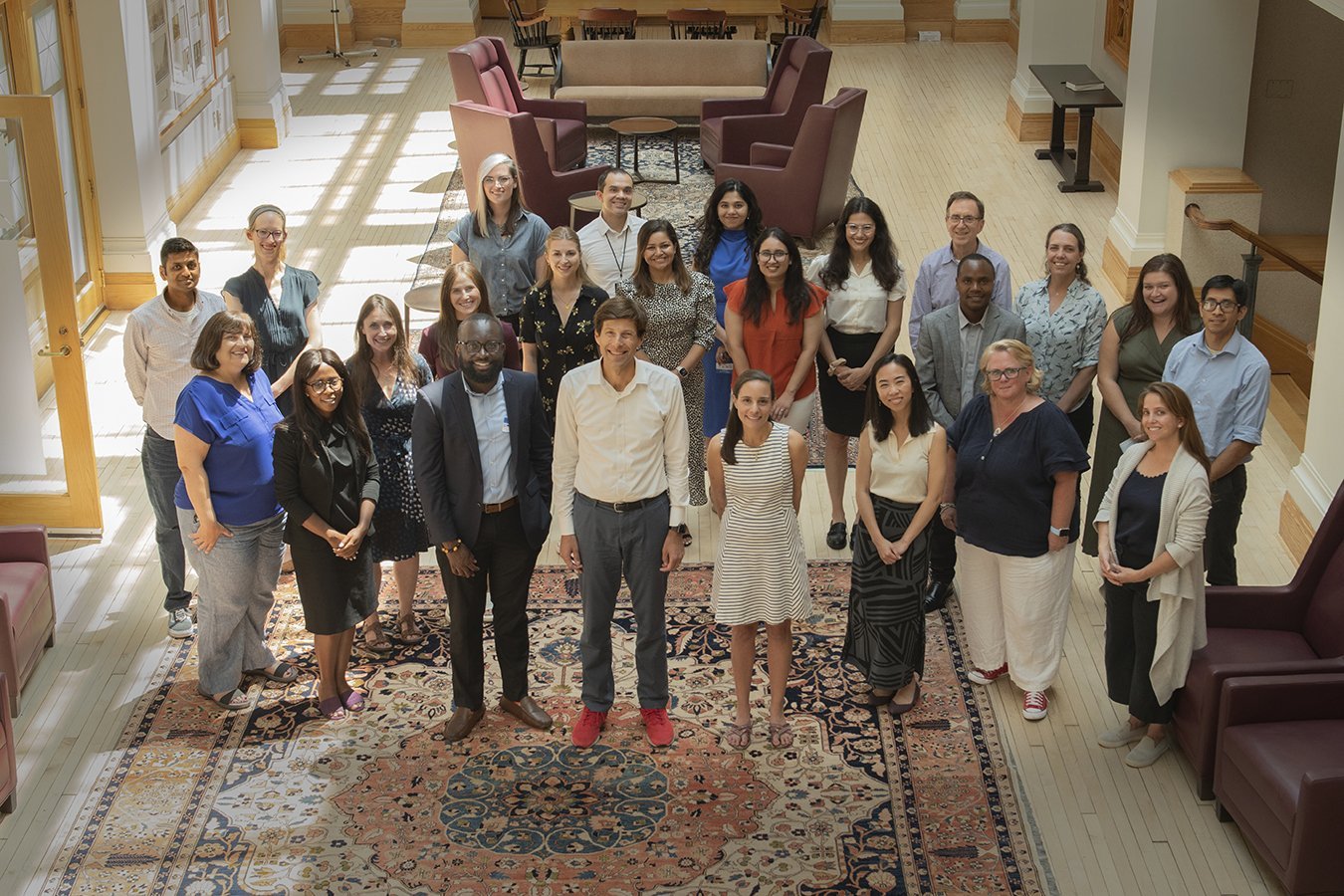Q&A: Center for Integration Science Aims to Break the Impasse on Global Health Equity
Staff from the Center for Integration Science in Global Health Equity gathered in November 2022 to celebrate the Center’s launch during an inaugural symposium. Dr. Gene Bukhman is center front. Photo by Stu Rosner.
Type 1 diabetes, sickle cell disease, and rheumatic and congenital heart disease. In the United States, if people with any of these diseases walk through a hospital’s doors, they can get treated. Their treatment is typically swift and, by and large, effective. Yet, in low-income nations, these conditions can be a death sentence, together claiming the lives of more than 175,000 children and adults living in extreme poverty every year. More than 80 percent of these deaths could be avoided if people living in poor, rural areas of low-income countries had access to the highly effective treatment routinely available in the United States and other wealthy countries.
The Center for Integration Science in Global Health Equity, a newly launched initiative at the Brigham, seeks to bridge this gap by bringing health coverage to those living in extreme poverty. By accelerating the just redistribution of health resources and creating global partnerships among health care professionals and activists working across disease spaces, the center seeks to increase tenfold the number of the world’s poorest people receiving lifesaving care for severe noncommunicable diseases by the year 2030.
Gene Bukhman, MD, PhD, a cardiologist and medical anthropologist at the Brigham and the founding executive director of the Center for Integration Science, has long advocated for a new “science of integration” to advance global health equity. Bukhman also directs the Program on Global Noncommunicable Disease and Social Change at Harvard Medical School and co-chaired a 2020 report, The Lancet NCDI Poverty Commission: bridging a gap in universal health coverage for the poorest billion.
The Center for Integration Science serves as the co-secretariat — along with the Universidade Eduardo Mondlane in Mozambique — for the NCDI Poverty Network, which now comprises 22 lower-income countries working together to implement the commission’s recommendations. At the heart of those recommendations, the commission called for progressive decentralization and integrated service delivery as a strategy for bringing quality care to lower levels of the health system that optimizes both health system efficiency and patient outcomes and well-being.
Bukhman recently spoke with CRN about the center’s mission and its unique approach to combating global health disparities and creating social change.
Q: What is the Center for Integration Science and who does it bring together?
The Center for Integration Science is a group of clinicians, researchers and administrators focused on moving health resources to the world’s poorest people. We’re doing this by finding new service delivery models that can expand health care and by mobilizing social movements to enact lasting change.
The center is a joint initiative of the Division of Global Health Equity at the Brigham, the Department of Global Health and Social Medicine at Harvard Medical School and Partners In Health. These departments and institutions are working together toward a common mission: developing a new field of science at the intersection of social medicine, health system design and service delivery design.
Q: Can you tell us more about the center’s mission and current goals?
Our mission is to accelerate global health equity by identifying integrated units of operational effectiveness and health care delivery, and then scaling implementation through collective action.
If you look at the last 10 years of global health solidarity, things have stalled. There was a lot of progress in the first decade of the 21st century, largely driven by a single disease: HIV/AIDS. No other disease has moved resources in the way that HIV/AIDS did in that decade.
In our research, we’ve found this is because there are gaps in financing for the treatment of noncommunicable, or noninfectious, diseases and injuries, like diabetes, heart failure and sickle cell anemia. So our aim is to take a new approach to break the impasse. We are doing that by forging new kinds of coalitions across multiple disease spaces and among people who treat, advocate for, or live with these diseases.
The best example of this is the PEN-Plus strategy, which stands for Package of Essential Noncommunicable Disease Interventions Plus. It’s an approach developed in the late 2000s at the Brigham with partners in Rwanda to simplify care for different types of severe, chronic noncommunicable diseases. In low-income countries, these diseases are typically treated by specialists, to whom few people have access. We identified the most essential elements of treating these conditions, trained nurses and other mid-level providers to deliver this care, and forged connections among advocates working on disparate diseases. PEN-Plus has since expanded to 14 countries.
This past year, all 47 countries of the World Health Organization’s African Region resolved to attain high levels of PEN-Plus coverage by 2030. One of the center’s goals is to help implement that expansion.
Q: What distinguishes the center from other initiatives and collaborations?
One major difference is that we’re developing models of service delivery at the same time we’re studying the sociology of advocacy movements. Braiding these crucial strands of work together is unusual in medicine and global public health.
Q: What does the center hope to accomplish in the future?
Currently, low-income countries have the resources to provide only $30 or $40 per person per year in health care services. In comparison, the United States spends nearly $10,000 per person annually. As a result, low-income countries can’t provide even basic care. We can move forward by mobilizing advocates across diseases. Doing that can support financing for service delivery models that address the needs of people with noncommunicable diseases.
In the case of PEN-Plus, we’re working with organizations like the Juvenile Diabetes Research Foundation, the Helmsley Charitable Trust and the American Heart Association, many of which are led by people directly affected by these diseases. It’s the first time these entities have worked together. That’s what we see as a road toward universal health coverage, particularly in lower-income countries.
What we’re envisioning is a global movement of people in both high- and low-income countries who are affected by these conditions to advocate together for universal health coverage.
Q: What are you most excited about as the center gets underway?
Collaborating with such wonderful colleagues. We have great partnerships with institutions in other nations, particularly the Universidade Eduardo Mondlane in Mozambique. Together, we support a 22-country NCDI Poverty Network. We’re excited to work closely with them, the World Health Organization, UNICEF, and our other partners to implement the PEN-Plus strategy and further develop the science of integration.
The center was born out of the Brigham’s storied legacy and focus on advancing our vision of a healthier community and a healthier world. As Dr. Higgins [Robert Higgins, MD, MSHA, president of Brigham and Women’s Hospital], said during the center’s launch, “What makes the Brigham stand out is our ability to create scalable innovation. And I think that there is no better example of this kind of world-changing innovation than the work going on here at the Center for Integration Science.”
Reprinted courtesy of Brigham Clinical & Research News

